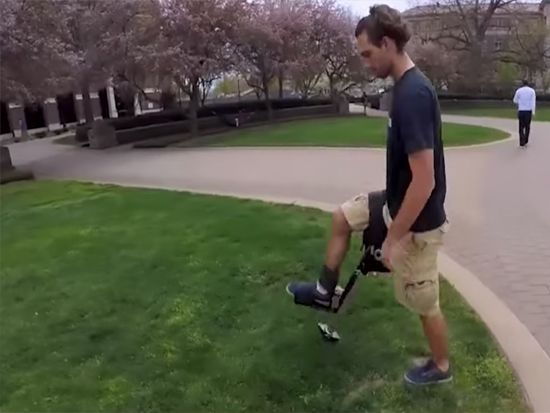Medical Inventor “Clutches” a Personal Mobility Device Patent

Medical Inventors, sometimes a personal injury or setback can trigger the genesis of new idea that radically transforms the way we perceive – and ultimately craft – a common medical device that has been around for decades. Consider this real-life example: When Brett Adams suffered a snowboarding injury, it dawned on him that his traditional crutches needed a drastic overhaul.
Along with other students at Purdue University, his approach was to throw them away and develop hands-free crutches that allow injured people to move around with a new sense of freedom, even when obstacles abound! Those of us who have experienced a leg injury, can attest to the frustration and clumsiness that attaches itself to common activities such as getting out of bed, climbing stairs or going grocery shopping.
Adam’s team realized a key problem had to be solved: “We needed to create a recovery device for injuries below the knee that could allow patients to go about their lives with little to no difficulty during the recovery process.”
This emphasis on natural movement led to the design, development and synthesis of a patented medical device that does not slip on icy surfaces or constrict natural blood circulation in the body. The business savvy team locked in a patent early on that protects the intellectual property around the quadricep-focused device they named the “Clutch Crutch”.
Their timing is apt, since recent studies estimate the market for personal mobility devices, including crutches and canes, will grow to $6 billion annually over the next five years. The motivated team used a technological approach to perfect the piston-centric medical device that transforms the walking experience. You can see their innovative approach below in this video:
I would also like to bring your attention one special spin-off feature of the medical device which illustrates how an idea may be extended into other uses that may not be immediately obvious. One of the team members used the knowledge gleaned from developing the patented clutches to build a sister software application that provides doctors with real-time data on how much force is being placed on the injured leg to aid in the tracking progress.
This process of linking cloud computing to physical devices has been referenced several times on my parent site, ThePatentProfessor.com including an interesting spinoff to the famous Rubik’s Cube. In this case, new phone apps (with ancillary machine learning capabilities) are being connected to one of the world’s best-selling toys in the cube gaming community. Many of my medical device patent attorney clients have pursued similar models and I invite you to contact me with ways you can do the same for your idea after a patent has been secured.
In both clutch-related examples above the medical device entrepreneurs are now using the patent protection to engage commercial partners to develop and launch the product in the personal mobility sector.
Larger established medical device companies are naturally interested in ground-breaking devices aimed at patients with orthopedic injuries or an aging population that experience injuries from falls. Sporting injuries and car accidents are two big contributing sectors to the growing need for clutch-assisted medical devices, so watch this space closely over the next year or two!
https://www.medicaldevicepatentattorneys.com/2019/07/medical-inventor-clutches-a-personal-mobility-device-patent/trackback/
